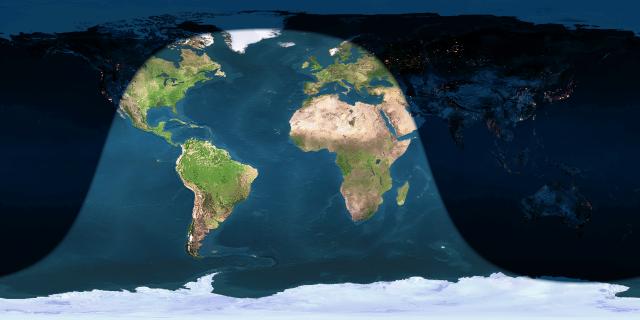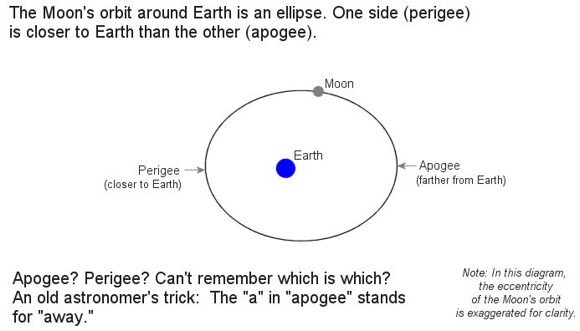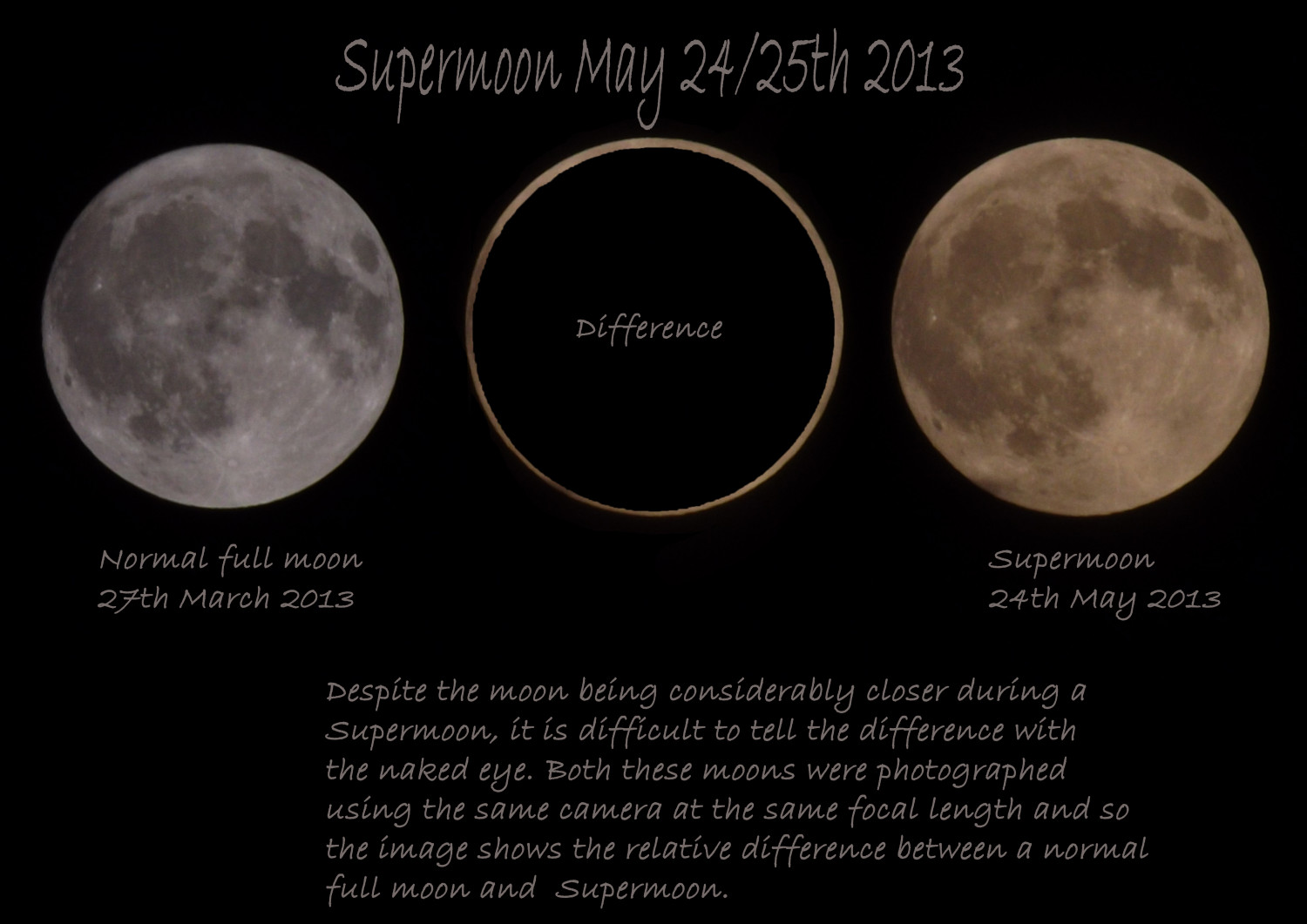Image at top: Stefano Sciarpetti
The full moon of November 14, 2016 is not only the biggest, closest and brightest supermoon of this year. It’s the closest supermoon since January 26, 1948. Should you watch for this full moon on the night of November 14? Sure, and, if you do, it’ll be beautiful. But, for us in the Americas the moon is closer to full on the night of November 13.
The moon turns precisely full on November 14, 2016 at 13:52 UTC. This full moon instant will happen in the morning hours before sunrise November 14 in western North America and on many Pacific islands, east of the International Date Line. (See worldwide map below.)
In Asia and Australia, the moon turns precisely full during the evening hours of November 14. In New Zealand, it actually happens after midnight November 15. Around the longitudes of Europe or Africa, look both nights.
Better yet … everyone, look both nights!
The moon will look plenty full and bright all night long on both nights – November 13 and 14 – as it rises in the east around sunset, climbs highest up around midnight, and then sets in the west at or near sunrise.
The moon won’t come this close to Earth again until November 25, 2034.

Want the exact time of full moon for North American time zones? Okay, so the moon will reach the crest of its full phase on November 14 at 13:52 UTC. That translates to 9:52 a.m. AST, 8:52 a.m. EST, 7:52 a.m. CST, 6:52 a.m. MST, 5:52 a.m. PST.
The moon will reach perigee – the moon’s closest point to Earth for this month – within an one and one-half hours of that time.
Extremely careful observers might notice it appears at its largest in our sky. Photo comparisons like the one at the top of this page, and the one below, will certainly show it. And all of us can notice that the moon will appear at its brightest in our sky. The moon won’t be so close and bright again for another 18 years.

We astronomers call this sort of close full moon a perigee full moon. The word perigee describes the moon’s closest point to Earth for any given month. Five years ago – when the closest and largest full moon fell on March 19, 2011 – many began using the term supermoon, which we’d never heard before. In the following years, we heard this term again to describe the year’s closest full moon on May 6, 2012, and again on June 23, 2013, and again on August 10, 2014, and yet again on September 28, 2015.
Now the term supermoon is being used a lot, and, personally, we approve! It’s a good descriptive term for the closest full moons, much easier to remember than perigee full moon.
Last month’s full moon – on October 16, 2016 – was also a supermoon. But the November full moon is even more super! In other words, the time of full moon falls even closer to the time of the moon’s closest point to Earth.
What does supermoon mean exactly? And how special is the November 14, 2016 supermoon? Follow the links below to find out more.
How often is moon both full and closest to Earth?
Will the tides be higher than usual?
Does a supermoon have a super effect on us?


What is a supermoon? The word supermoon didn’t come from astronomy. Instead, it came from astrology. Astrologer Richard Nolle of the website astropro.com takes credit for coining the term supermoon. In 1979, he defined it as:
…a new or full moon which occurs with the moon at or near (within 90% of) its closest approach to Earth in a given orbit (perigee). In short, Earth, moon and sun are all in a line, with moon in its nearest approach to Earth.
By this definition, according to Nolle:
There are 4-6 supermoons a year on average.
That doesn’t sound very special, does it? In fact, the November 14 full moon lines up much more closely with perigee – the moon’s closest point to Earth – than Nolle’s original definition, which allows for a fairly wide latitude between full moon and perigee. The 2016 November full moon happens only about one and one-half hours after the moon reaches perigee, the moon’s closest point to Earth for this month and year. At perigee, the moon lies only 356,509 kilometers (221,524 miles) away. Two weeks before, on October 31, the moon swung out to apogee – its farthest point for the month and year – at 406,662 kilometers (252,688 miles) distant.
How super is this supermoon? November 14 presents the moon’s closest encounter with Earth in over 68 years, since January 26, 1948. The full moon on November 14, 2016, will feature the closest full moon (356,509 kilometers) until November 25, 2034 (356,448 kilometers)! Maybe this helps you see that supermoons – while interesting – are fairly routine astronomical events.
Even the proximity of full moon with perigee isn’t all that rare. The extra-close moon in all of these years – 2011, 2012, 2013, 2014, 2015 and 2016 – finds the full moon taking place at or nearly the same hour as lunar perigee. More often than not, the closest perigee of the year (sometimes called proxigee) comes on the one day of the year that the full moon and perigee most closely coincide. (See table below.)
Moon closest to Earth
| Year | Date | Distance | 2011 | March 19 | 356,575 km | 2012 | May 6 | 356,955 km | 2013 | June 23 | 356,991 km | 2014 | August 10 | 356,896 km | 2015 | September 28 | 356,877 km | 2016 | November 14 | 356,509 km |
How often is moon both full and closest to Earth? Closest full moons recur in cycles of 14 lunar (synodic) months, because 14 lunar months almost exactly equal 15 returns to perigee (moon’s closest point to Earth). A lunar month refers to the time period between successive full moons, a mean period of 29.53059 days. An anomalistic month refers to successive returns to perigee, a period of 27.55455 days. Hence:
14 x 29.53059 days = 413.428 days
15 x 27.55455 days = 413.318 days
This time period is equal to about 1 year, 1 month, and 18 days. The full moon and perigee will realign again on January 2, 2018, because the 14th full moon after the 2016 November 14 full moon will fall on that date.
Looking further into the future, the perigee full moon will come closer than 356,500 kilometers for the first time in the 21st century (2001-2100) on November 25, 2034 (356,446 km). The closest full moon of the 21st century will fall on December 6, 2052 (356,425 km).
For the moon to come closer than 356,400 kilometers (221,457 miles) is quite a feat. In fact, this won’t happen at all in the 21st century (2001-2100) or the 22nd century (2101-2200). The last time the full moon perigee swung this close to Earth was on January 14, 1930 (356,397 km), and the next time won’t be till January 1, 2257 (356,371 km).

Will the tides be higher than usual? Yes, all full moons bring larger-than-usual tides, and perigee full moons bring the highest (and lowest) tides of all. Each month, on the day of the full moon, the moon, Earth and sun are aligned, with Earth in between. The line-up of the sun and moon creates wide-ranging tides, known as spring tides. High spring tides climb up especially high, and, on the same day, low tides plunge especially low.
The extra-close full moon accentuates these monthly (full moon) spring tides all the more.
If you live along a coastline, watch for high tides caused by the November 14 perigee full moon – or supermoon – over the next several days. Will the high tides cause flooding? Probably not, unless a strong weather system moves into the coastline where you are.
Still, keep an eye on the weather, because storms do have a large potential to accentuate high spring tides.
The highest tides will tend to follow the crest of the moon’s full phase (November 14, 2016 at 1352 UTC) by a day or two.
Bottom line: The full moon of November 14, 2016, is the closest and largest full moon of this year. By a somewhat new definition – one that has entered the world of astronomy from astrology – many will call it a supermoon. There are three full moons in 2016 that meet the definition of a supermoon – October, November and December. But this November 14 full moon is the most super of the supermoons! A super-duper moon!
Looking for a tide almanac? EarthSky recommends . . .
Each full moon has its own name. Here’s a list.
EarthSky astronomy kits are perfect for beginners. Order yours today.











